Slovenia is the first country in Europe to declare an end to its COVID epidemic. It’s not entirely clear what this means or rather how close the country will go to returning to ‘normal’. But schools are reopening and restaurants, bars and small hotels will be able to open next week.
The decline in cases is real. The country of two million has had fewer than seven new cases per day for the last two weeks. The total for those 14 days is 31. So the total number is actually significantly under that 7 per day cap.
If we take 7 per day, in per capita terms, that would be the equivalent of maybe 1,000 to 1,250 cases per day nationwide in the United States. Yesterday the US had just over 25,000 new cases. So it’s fair to say we have some catching up to do. The best thing you can say about the situation in the US – and that is not nothing – is that on a national level the pace of new cases per day has stabilized and appears to be slowly declining.


This brings me to a different question: what is a new normal and what things are worth doing in the new normal?
Like the bar image above, here’s another example to frame the question.
NEW: Casino in Hialeah, Florida tests their updated poker tables. pic.twitter.com/VEQ6XuJZAO
— Andy Slater (@AndySlater) May 14, 2020
Bars and casinos have something in common. They are both based on potentially addictive behavior. Many people who partake aren’t doing it to have fun; they’re addicts.
So let’s set those examples aside. Let’s talk about fancy restaurants or to take a fun example, Mar a Lago, which has announced that it will partially reopen tomorrow. We all need to eat. Most of us require some regular human, in-person contact with loved ones and friends. Most of us need to get outdoors for some amount of time. We’re willing to make some sacrifices and take some risks to do those things.
But let’s take the example of a fancy restaurant or really any in-person restaurant, whether it’s a crazy-priced fancy place or just your local sports bar with table service where you’re ordering wings and onion rings and sodas with free refills. To me at least a lot of the pleasure of that experience is the carefree-ness, the focus on the pleasure of good food and time with the people you’re with. If we’re all wearing masks and sanitizing the silverware and we’re six feet away from the next table and the waiter is decked out in some level of PPE, a lot of the point of the exercise is lost. At a basic level I’m constantly reminded that I need to take steps to avoid getting a potentially life-threatening disease; and that’s a pretty big buzzkill.
A lot of what I think we’re getting in those activities is precisely the ability not to worry about things. A certain level of focus on hand hygiene and physical distance and masking just defeats the purpose. To take the example in the article photo above, if going to a bar means having an improvised plastic sheet built on PVC piping separating me from the person to my right and my left, is that really going to a bar that has any of the fun and sociality most of us associate with it? If that’s working for you maybe you have a drinking problem.
Haircuts and salons are different. People want to look good or at least presentable and feel like their best selves. There’s some enjoyment tied to going to a salon for many people. And that may be curtailed to an extent by protective procedures. But mainly you want to look good or look like the self you’re accustomed to so you’ll accept some small additional risk to get that done. And if the salon or barber is doing some social distancing and masking and other steps to make it safer that’s a plus.
Similarly with various kinds of shops and grocery stores, going to them may not be quite as carefree. But you can’t order everything online. So you’ll go because life is never without risks and you’ll find the level you’re comfortable with and that will be your thing.
What I think this tells us is that a lot of the ‘reopening’ debate won’t be governed by public orders but by public behavior. ‘Reopening’ is the ultimate democratic process since we are all voting constantly with our feet. Restaurants may be allowed to reopen for in-person service but that doesn’t mean people will go to them at anything like the pre-COVID levels. Restaurants are not readily scalable. They need a certain level of business to be viable. A restaurant ordered to operate at 25% or 50% occupancy in many cases probably cannot run. It costs a certain amount just to keep the doors open and half the level pre-COVID business just isn’t viable. And that is the case whether you’re operating under a public order or whether there are just dramatically fewer people who want to eat out.
The issue becomes less what’s safe and what’s allowed as what’s enjoyable, what’s worth your time and your money.






